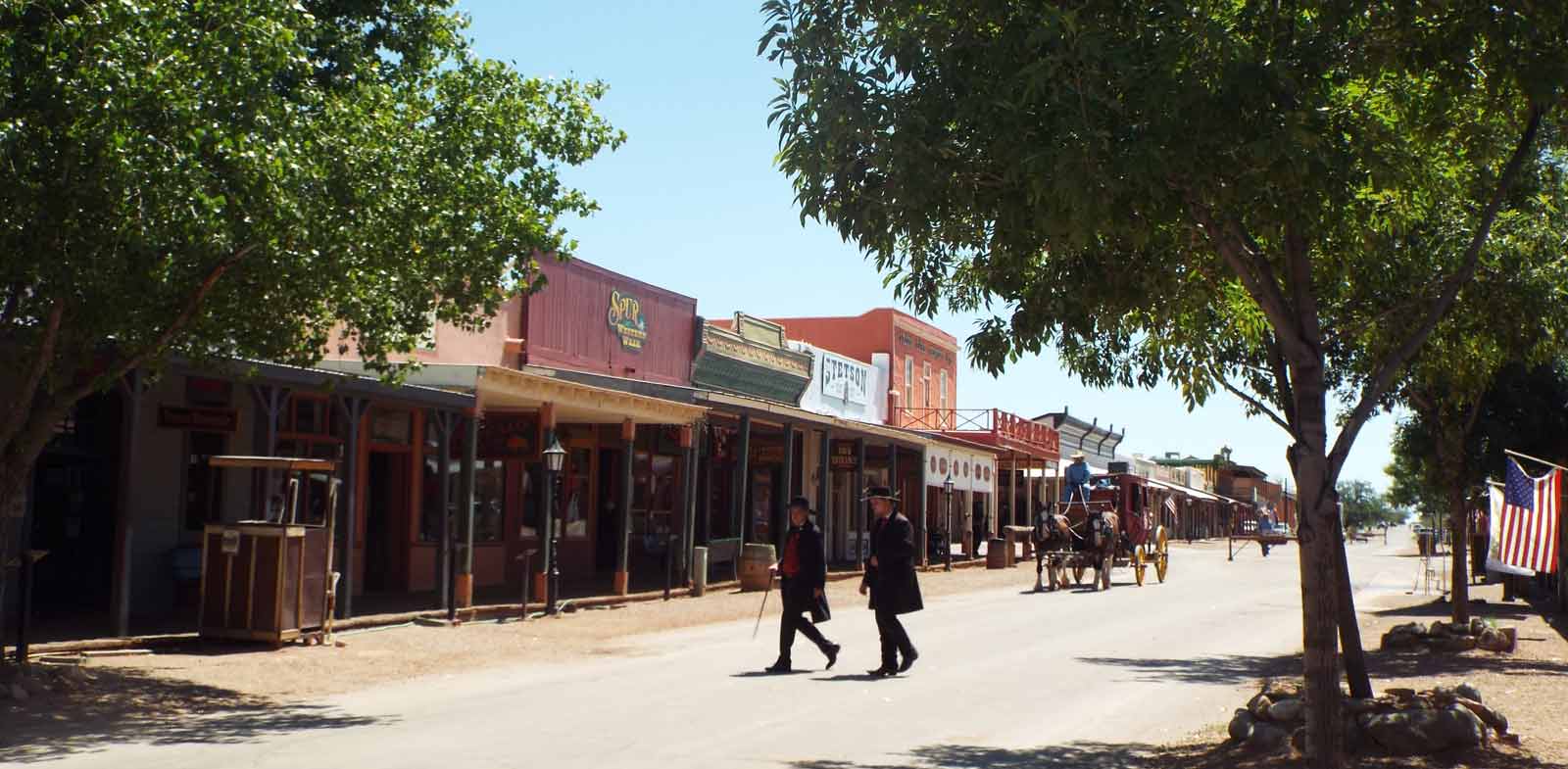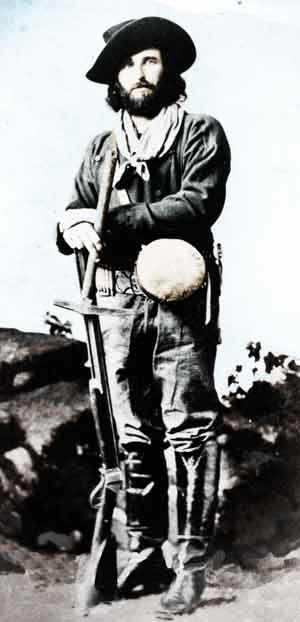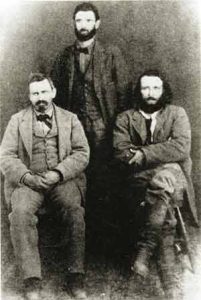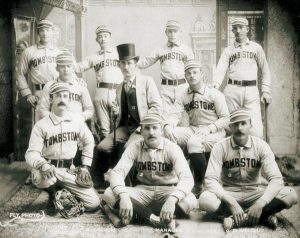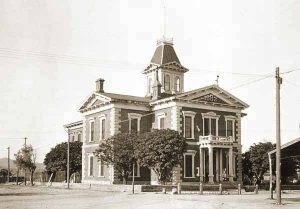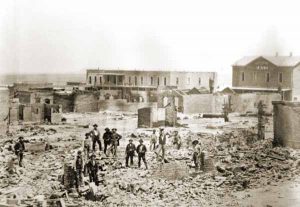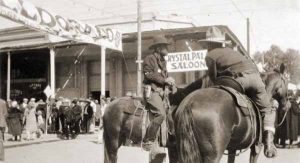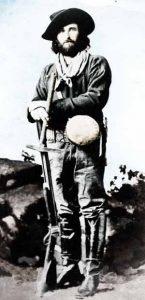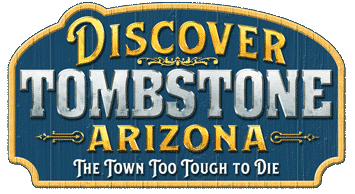
~ A HISTORY OF TOMBSTONE ARIZONA ~
~ A HISTORY OF TOMBSTONE ARIZONA ~
Tombstone, Arizona has a unique history that began with Silver Mining and evolved into a Western Tourist destination giving Tombstone the title of "The Town Too Tough to Die".
Tombstone, Arizona has a unique history that began with Silver Mining and evolved into a Western Tourist destination giving Tombstone the title of "The Town Too Tough to Die".
A History of Tombstone, Arizona
by Don Taylor
(Tombstone City Historian)
A History of Tombstone, Arizona
by Don Taylor
(Tombstone City Historian)
As the history of the American west was being made, individuals and places became famous. Today the mere reference to these names conjures up images of legendary people and towns of the old west, in the minds of people all over the world. There is one place that still grabs our imaginations and interests today, Tombstone, Arizona. It was Ed Schieffelin’s discovery of silver in the hills of Southeastern Arizona Territory that made this place an American legend. Without his courage, tenacity, and vision, the area known as Tombstone would still be called Goose Flats. Ed Schieffelin wanted to explore the region near the former Chiricahua Reservation to the south. But Ed was not so naïve as to enter this region alone. He joined a party of Hualapai scouts, under the command of Second Lieutenant Robert Hanna, who were relocating to Camp Huachuca to pursue renegade Chiricahua Apaches. Using Camp Huachuca as a base, Ed trailed after several scouting parties, but this tactic failed to provide adequate time for prospecting. Soon he struck out alone, and each time he returned the soldiers asked him what he had found. Ed would admit that he had not found anything and rebut that he would someday soon. This always tickled the soldiers, and they would reply that the only thing Ed would find in these hills was his tombstone.
After finding what he expected to be a “mother lode” he sought out his brother Al and found him at the McCracken Mine near Globe, AZ. The Schieffelin brothers had Richard Gird assay Ed’s ore samples, ‘The Tombstone’ assayed out to $2,000.00 per ton, and Gird financed the new partnership back to Ed’s claim. When the three reached a cabin near The San Pedro River, “the ball was open,” as they said back then. As their mining operation grew, so did the need for men. Soon a tent community sprang up, and when word got out about the silver in the area this village grew in to a metropolis almost overnight. In late 1879, their two best mines were projecting dividends of $50,000.00 per month for the next two years.
As communities began to develop around the Tombstone mines and stamp mills, the “Cowboys” settled on ranches surrounding these canvas villages and provided beef at less than market rates with cattle stolen from Mexico. It was a perverse supply and demand scenario. The “Cowboys” supplied the beef the growing population demanded through rustling. But as these settlements grew into cities and towns, and the rich silver ore was transformed into bullion, the “Cowboys” began to demand the supply. After months of lawlessness around Tombstone and in Sonora, Mexico, the friction between the Wyatt Earp, his brothers Virgil and Morgan, their friend “Doc” Holliday, and the “Cowboys” all came to a head. On a cold, snowy and windy October 26, 1881, the most famous gunfight in the American West took place between the two factions. For six more months hostilities would continue until Earp left the Territory in April of 1882. Wyatt Earp lived in Tombstone for 28 months.
Tombstone, Arizona has never been the wild, “gun-toting,” “shoot-em-up” place it has been made out to be. It was very modern, sophisticated, and extremely wealthy. Telephones were installed in Tombstone in 1882. By 1883, the City had two gas companies; three water companies; two ice companies; five ice cream parlours; fresh seafood was delivered daily from Baja, Mexico; west of the city was a track for horse racing and on the infield of the racetrack was a baseball diamond. Tombstone had a baseball team from 1882-1929. The first swimming pool in Arizona Territory was built at the north end of Fifth Street. The mining camp became a metropolis that rivaled San Francisco, California.
In February of 1881, Tombstone was designated as the County Seat for the newly created Cochise County. 50,000 bricks were used to build the Cochise County Courthouse at the corner of 3rd Street and Toughnut Street. It served as the County offices until 1929 when Bisbee became the new County Seat. The building would become the second Arizona State Park ever created, and the first State Park to open. It serves as a wonderful museum today. Boothill Cemetery was Tombstone’s third graveyard. It was full by 1884 and the current City Cemetery was created. It is estimated that there are between 250 and 440 people buried at Boothill. Outlaws and respected citizens share this hallowed ground, and it is open to visit daily.
The “Town Too Tough to Die” would experience two major fires in the downtown business district. The first inferno happened in June of 1881 and the second blaze 11 months later in May of 1882. After each catastrophe, Tombstone was rebuilt in six months.
Mining continued and the shafts reached the water table in 1881. Two huge Cornish pumps were brought in and at their peak capacity; they were pumping 2,500,000 gallons of water each day out of the mines. Tombstone’s prosperity would fluctuate with the national economy and the price of silver.
Both reached their lowest in 1889, and after the pumps failed, mining operations virtually ceased.
1902 would bring a resurrection to Tombstone when E.B. Gage returned to these hills and reopened the mines. This second mining boom would actually last longer than the first, 1902-1923. During this period the railroad came to Tombstone. Once again, the city became a national and international sensation again.
By 1923, the mines would close on a corporate level forever. William Kelly, the editor and owner of The Tombstone Epitaph newspaper, funded and produced Tombstone’s 50th “birthday party,” the event was called “Helldorado.” The City and Kelly invited 400 of Tombstone’s pioneers to come, and 343 came. The event was a tremendous success but fell on the heels of the stock market crash. Not to be deterred, the event has continued each year, except during World War II. Following the war, Tombstone became a sleepy, little town in the high Sonoran desert of Arizona, but Tombstone has never been a “ghost town.”
Books, comics, movies, and television would boost Tombstone back into the public consciousness in the 1950s and 1960s. These portrayals would reach their pinnacle in 1993 and 1994. The movies “Tombstone” and “Wyatt Earp” made the City a “celebrity” one more time. Thousands of visitors come to Tombstone because of these films. They are great entertainment, but extremely loose interpretations of the actual historic record. It is up to you to embark on a new adventure and travel to Tombstone.
Come see the actual places all of these famous events occurred. Walk the same streets these legendary men and women did in those pioneer days. Come learn the real stories of “the town too tough to die.”
Discover Tombstone, Arizona. History lives here every day!
As the history of the American west was being made, individuals and places became famous. Today the mere reference to these names conjures up images of legendary people and towns of the old west, in the minds of people all over the world. There is one place that still grabs our imaginations and interests today, Tombstone, Arizona. It was Ed Schieffelin’s discovery of silver in the hills of Southeastern Arizona Territory that made this place an American legend. Without his courage, tenacity, and vision, the area known as Tombstone would still be called Goose Flats. Ed Schieffelin wanted to explore the region near the former Chiricahua Reservation to the south. But Ed was not so naïve as to enter this region alone. He joined a party of Hualapai scouts, under the command of Second Lieutenant Robert Hanna, who were relocating to Camp Huachuca to pursue renegade Chiricahua Apaches. Using Camp Huachuca as a base, Ed trailed after several scouting parties, but this tactic failed to provide adequate time for prospecting. Soon he struck out alone, and each time he returned the soldiers asked him what he had found. Ed would admit that he had not found anything and rebut that he would someday soon. This always tickled the soldiers, and they would reply that the only thing Ed would find in these hills was his tombstone.
After finding what he expected to be a “mother lode” he sought out his brother Al and found him at the McCracken Mine near Globe, AZ. The Schieffelin brothers had Richard Gird assay Ed’s ore samples, ‘The Tombstone’ assayed out to $2,000.00 per ton, and Gird financed the new partnership back to Ed’s claim. When the three reached a cabin near The San Pedro River, “the ball was open,” as they said back then. As their mining operation grew, so did the need for men. Soon a tent community sprang up, and when word got out about the silver in the area this village grew in to a metropolis almost overnight. In late 1879, their two best mines were projecting dividends of $50,000.00 per month for the next two years.
As communities began to develop around the Tombstone mines and stamp mills, the “Cowboys” settled on ranches surrounding these canvas villages and provided beef at less than market rates with cattle stolen from Mexico. It was a perverse supply and demand scenario. The “Cowboys” supplied the beef the growing population demanded through rustling. But as these settlements grew into cities and towns, and the rich silver ore was transformed into bullion, the “Cowboys” began to demand the supply. After months of lawlessness around Tombstone and in Sonora, Mexico, the friction between the Wyatt Earp, his brothers Virgil and Morgan, their friend “Doc” Holliday, and the “Cowboys” all came to a head. On a cold, snowy and windy October 26, 1881, the most famous gunfight in the American West took place between the two factions. For six more months hostilities would continue until Earp left the Territory in April of 1882. Wyatt Earp lived in Tombstone for 28 months.
Tombstone, Arizona has never been the wild, “gun-toting,” “shoot-em-up” place it has been made out to be. It was very modern, sophisticated, and extremely wealthy. Telephones were installed in Tombstone in 1882. By 1883, the City had two gas companies; three water companies; two ice companies; five ice cream parlours; fresh seafood was delivered daily from Baja, Mexico; west of the city was a track for horse racing and on the infield of the racetrack was a baseball diamond. Tombstone had a baseball team from 1882-1929. The first swimming pool in Arizona Territory was built at the north end of Fifth Street. The mining camp became a metropolis that rivaled San Francisco, California.
In February of 1881, Tombstone was designated as the County Seat for the newly created Cochise County. 50,000 bricks were used to build the Cochise County Courthouse at the corner of 3rd Street and Toughnut Street. It served as the County offices until 1929 when Bisbee became the new County Seat. The building would become the second Arizona State Park ever created, and the first State Park to open. It serves as a wonderful museum today. Boothill Cemetery was Tombstone’s third graveyard. It was full by 1884 and the current City Cemetery was created. It is estimated that there are between 250 and 440 people buried at Boothill. Outlaws and respected citizens share this hallowed ground, and it is open to visit daily.
The “Town Too Tough to Die” would experience two major fires in the downtown business district. The first inferno happened in June of 1881 and the second blaze 11 months later in May of 1882. After each catastrophe, Tombstone was rebuilt in six months.
Mining continued and the shafts reached the water table in 1881. Two huge Cornish pumps were brought in and at their peak capacity; they were pumping 2,500,000 gallons of water each day out of the mines. Tombstone’s prosperity would fluctuate with the national economy and the price of silver.
Both reached their lowest in 1889, and after the pumps failed, mining operations virtually ceased.
1902 would bring a resurrection to Tombstone when E.B. Gage returned to these hills and reopened the mines. This second mining boom would actually last longer than the first, 1902-1923. During this period the railroad came to Tombstone. Once again, the city became a national and international sensation again.
By 1923, the mines would close on a corporate level forever. William Kelly, the editor and owner of The Tombstone Epitaph newspaper, funded and produced Tombstone’s 50th “birthday party,” the event was called “Helldorado.” The City and Kelly invited 400 of Tombstone’s pioneers to come, and 343 came. The event was a tremendous success but fell on the heels of the stock market crash. Not to be deterred, the event has continued each year, except during World War II. Following the war, Tombstone became a sleepy, little town in the high Sonoran desert of Arizona, but Tombstone has never been a “ghost town.”
Books, comics, movies, and television would boost Tombstone back into the public consciousness in the 1950s and 1960s. These portrayals would reach their pinnacle in 1993 and 1994. The movies “Tombstone” and “Wyatt Earp” made the City a “celebrity” one more time. Thousands of visitors come to Tombstone because of these films. They are great entertainment, but extremely loose interpretations of the actual historic record. It is up to you to embark on a new adventure and travel to Tombstone.
Come see the actual places all of these famous events occurred. Walk the same streets these legendary men and women did in those pioneer days. Come learn the real stories of “the town too tough to die.”
Discover Tombstone, Arizona. History lives here every day!
